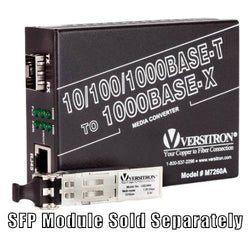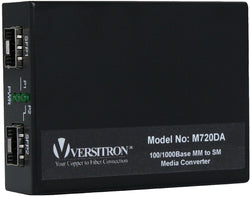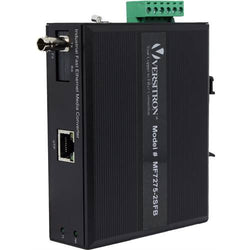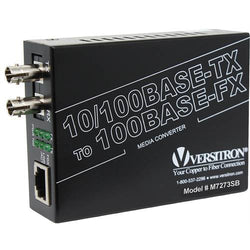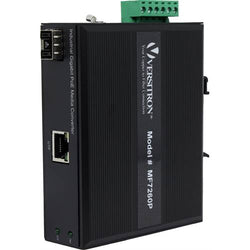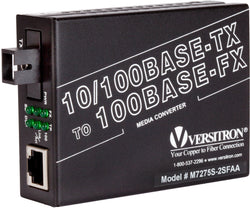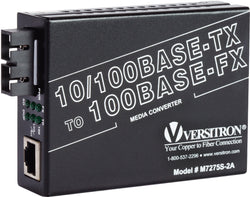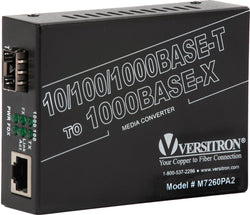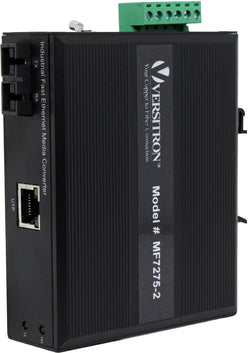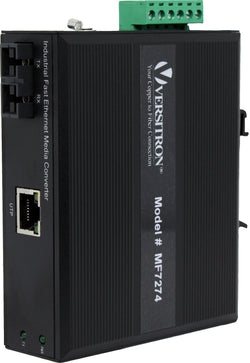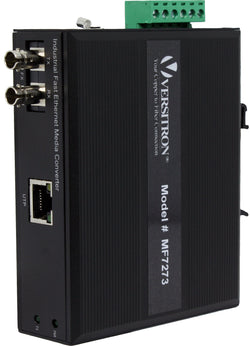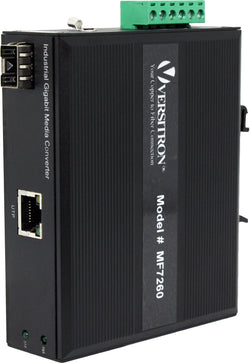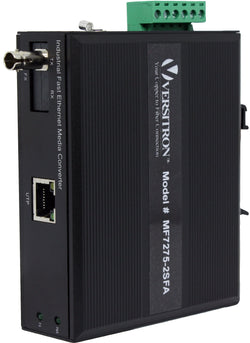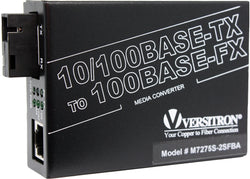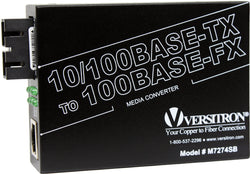Fiber Optic Media Converters
Versitron’s fiber media converters seamlessly bridge connectivity gaps between dissimilar networks, enabling transmissions over distances of up to 62.1 miles (100km). Ideal for longer-distance networking solutions across various applications including business networks, security and surveillance systems, government and defense sectors, and more.
Our fiber optic media converters are available in both multi-mode (SX/LX) and single-mode (LX) configurations featuring multiple connector types, including LC, SC, or ST connectors for fiber cables, and RJ45 connectors for copper cables.
Fiber Optic Media Converters Offered by VERSITRON
- 1000Base Gigabit Media Converter: These media converters are designed to convert 10/100Base or 1000Base Ethernet to 1000Base Gigabit speeds over fiber utilizing the latest SFP technology.
- 10/100Base Fast Ethernet Media Converters: Also known as our “Double Duty” media converters, these devices are designed to convert a 10/100Base Fast Ethernet UTP electrical signal into light signals for transmission over Multimode or Single mode fiber optic cables. Therefore, these devices can provide either 10 Mbps or 100 Mbps networking speeds on the Ethernet side.
- Single Fiber Media Converters: These media converters are designed to transmit and receive signals over one strand of fiber optic cable. Single fiber media converters can accommodate either 10Base or 100Base networks or both. There are three network speed settings: 10/100 auto-sensing, 10Base fixed, or 100Base fixed. Gigabit networking speeds are also accomplished using SFP modules with single fiber capability.
- Industrial Media Converters: These converters are designed to operate in harsh environmental conditions. Typical features of these categories of media converters include full wire-speed performance, SFP flexibility, best conversion latency, link fault pass-through, and low power consumption, among others.
- PoE Media Converters: Would you like to provide reliable and cost-effective fiber distance extension to PoE powered devices? We are here to help! VERSITRON models of PoE media converters provide solutions for PSE devices such as IP cameras as well as other networking devices in remote areas.
- Multimode to Single Mode Converters: These converters provide efficient solutions when network distance requirements exceed the limit of MM fiber or to interconnecting multimode fiber LANs over longer distances.
- SFP Modules: Designed to meet your high-speed networking needs, our industry-standard small form factor pluggable (SFP) modules are compatible with multiple VERSITRON products. SFP Modules are available for Multimode SX, Multimode LX, Single mode LX, and Single mode ZX.
- Media Converter Chassis: we also offer a 14-slot chassis that can house up to 14 Media Converters at one specific location.
Features of Fiber Ethernet Converters
Our variety of fiber media converters both managed and unmanaged, combines the following features:
- Full Wire Speed Conversion: Ensures efficient data transmission at maximum speeds.
- Protocol Compliance: Our converters adhere to IEEE 802.3, 802.3ab, 802.3u, and 802.3z protocols, ensuring compatibility and standard compliance.
- Auto-Negotiation and MDI/MDI-X Detection: Includes auto-negotiation and auto MDI/MDI-X detection features for seamless connectivity.
- Long Transmission Range: Our fiber Ethernet converters are capable of transmitting data over distances of up to 100km, ensuring reliable communication.
- Rugged Design: Designed to withstand high temperatures and harsh environmental conditions for durability and reliability.
- Triple Duty Support: Provides versatile support for various network configurations and applications.
- Bi-Directional Communication Options: Offers options for bidirectional communication to suit diverse networking needs.
- CWDM Communication Options: Ethernet to fiber converters provide compatibility with Coarse Wavelength Division Multiplexing (CWDM) technology for enhanced networking capabilities.
- Installation Flexibility: Can be installed standalone or within the MCC-14R chassis for convenient deployment and management.
Applications of Fiber to Copper Media Converters
- Business Networks
- Security and Surveillance Systems
- Government and Defense Sectors
- Industrial Premises
- Telecommunications
Why Choose Versitron’s Fiber Media Converters?
- All fiber optic media converters come with a best-in-class lifetime warranty.
- We offer prompt responses to your inquiries, along with free unlimited sales and technical support.
- Our products are proudly manufactured in the United States, guaranteeing high quality and reliability.
- With over six decades of experience, Versitron has been a trusted provider, safeguarding communications since 1958.

